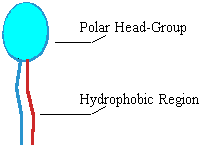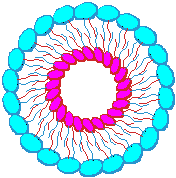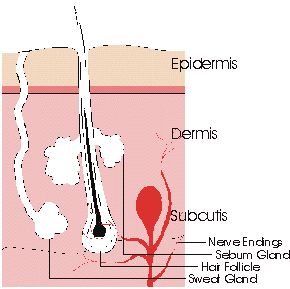
![]()
with
our proprietary
![]()
![]()
![]()
 |
|
New Equilibrium cosmeceuticals are deep-penetrating skin-care products formulated into a topical delivery system which provides health-boosting ingredients for better and healthier skin. New Equilibrium cosmeceutical formulae may contain ingredients that have healing properties when administered orally or intravenously, but they are not medicine and are not claimed to be medicine when applied topically to the skin.
Our products contain emulsions that are made of extra-tiny droplets of the most luxurious oils that nature provides. These droplets are sub-micron in size and are measured on the nanometer scale. Our formulae are made with a multitude of extra-tiny droplets organized in a digital array dispersion (DAD), with each extra-tiny droplet acting as a distinctive entity among the multitude.
Many products create a continuous oil layer that can clog skin pores and block the free movement of materials such as air, water, and vitamins in the epidermis; in contrast, our Digital Array Dispersions form a non-continuous matrix in which the oil is reduced to extra-tiny droplets that are separated from each other and allow air or water-soluble materials to move among them. The tinier the droplets, the less likely they are to clog pores, the more materials can flow through, and the faster and deeper the formula can be absorbed. Continuous oil layers are less likely to be absorbed and they leave a greasy layer on the skin. Our extra-tiny Digital Array Dispersions are absorbed extremely quickly and do not leave continuous greasy deposits on the skin. Our extra-tiny Digital Array Dispersions, made of expensive luxurious oils, create a light and luxurious feel on the skin and are unlikely to clog pores. In fact, our extra-tiny Digital Array Dispersion can help in the clearing of existing oily skin clogs by "chipping" away oil molecules from the larger oil deposits that the skin has discarded.
Our products do not contain mineral oils. Mineral oils are petroleum distillates or chemically modified petroleum distillates. Mineral oils are reported to have damaging effects on skin in prolonged use, and are suspected to be addictive in a way that is reminiscent of addiction caused by fumes of certain organic solvents.
Our products do not contain harmful emulsifiers. Emulsifiers are categorized as soaps or detergents, prolonged exposure to which can damage the skin. Our emulsions are made with our high-technology proprietary emulsification methods (patent applications in process), and are skin-friendly.
Our Nanosome technology utilizes the most practically effective tool for bi-directional delivery of both water- and oil-soluble ingredients in the skin. "Nanosome" is the trademark of our proprietary "Very Small Single Layer Phosphatidylcholine Liposomes", and is explained below.
Phospholipids, illustrated in Figure 1, are the building blocks of cell membranes and liposomes.

Phospholipids are organized as a bilayer network, illustrated in Figure 2, with their polar head groups pointing toward the water and their hydrophobic regions pointing at each other. Such a bilayer, containing proteins and other molecules, surrounds the cell content and comprises the cell membrane. Cell membranes control the flow of nutrients into and out of cells and regulate vital cell functions.

Liposomes are similar to cell membranes. They are ball-shaped phospholipid bilayers that are spontaneously formed when phospholipids are submerged in water. Spontaneously formed liposomes are generally large (over a micron in size) and are multilayered or multilamellar (many ball-shaped bilayers stuffed one within the other). Such liposomes have poor interaction with their surroundings, and perform poorly as a delivery system.
Microns and nanometers are microscopic units of measure. A micron is approximately 1/25,000 of an inch; objects this size can not be seen with the naked eye, but may be seen through an optical microscope. A nanometer is one thousandth of a micron. Objects this size can not be seen through an optical microscope and may only be detected by an electron microscope.
Nanosomes, shown in Figure 3, are the trademark name of our proprietary very small liposomes, predominantly 50 nanometers or smaller in size. Nanosomes are comprised of a single phospholipid bilayer. Nanosomes are not formed spontaneously; they are created by down-sizing large liposomes with ultrasonic energy. This energy-intensive process is extremely delicate, so we produce Nanosomes in small, carefully-monitored batches.

Nanosomes are interactive liposomes, making them not only a powerful delivery system of beneficial nutrients to the skin, but also a powerful removal system for oily discards. Via the cell membrane, they can deliver many molecules to cells, including the cells' own building blocks, the phospholipids. They can also remove from cells various molecules via their membranes, including phospholipids and cholesterol. Nanosomes can also exchange molecules with cell membranes, giving them the molecules they need and taking from them molecules they should discard.
The chemical composition of cells changes as they age. As cell membranes age, the amount of one phospholipid, phosphatidylcholine (PC), decreases and the amount of another phospholipid, sphingomyelin (SM), increases. Nanosomes that are composed almost entirely of PC can add needed PC to the aging cell membranes and remove excessive SM. This exchange is a natural attempt to reach chemical equilibrium between the Nanosomes and the cells they contact, including cells that are not contacted directly by the Nanosomes.
In our past studies of cell-liposome interactions, we discovered that increasing PC and decreasing SM in cell membranes promoted an avalanche of other improvements in cells, including at least 35% increase in the life spans of rats that were injected with small PC-enriched liposomes intravenously.
The skin is the largest organ in the body; its complex structure is illustrated in Figure 4. In a healthy adult human, it can weigh 25 pounds or more. The skin is not merely a "shrink wrap" barrier surrounding the body but handles many essential metabolic functions, some of which no other organ but the liver can process; for example, only the skin can transform 7-dehydrocholesterol into the essential nutrient vitamin D3.
The skin can be divided into three defined structures: the outer layer or the epidermis, the intermediate layer or the dermis, and the inner layer or the subcutis. The epidermis carries out most of the physical, chemical, and immunological defense tasks of the skin. The structural strength and elasticity of the skin is provided by the connective tissue of collagen and other elastic fibers at the upper layers of the dermis. The central and lower layers of the dermis and the subcutis contain adipose tissue, sebum and sweat glands, hair follicles, and the lower layers of the connective tissue.

The skin is difficult to penetrate. If liposomes reach deep into the skin, they can produce a beneficial environment that may promote the liveliness and the well being of intact live cells located in their vicinity and effect them in a way similar to that we achieved in laboratory studies. Current literature indicates that some larger liposomes acting as vehicles for other substances have reached into the stratum corneum layer of the skin (the outer layer of the epidermis which is also the ultimate high-resistance skin barrier).
Since our Nanosomes are very small and interactive, and are designed almost entirely of PC, they can be highly beneficial to skin cells. However, Nanosomes in our skin formulae are not a medicine, and we do not claim that Nanosomes have any medicinal virtue for curing diseases when applied to the skin. Nanosomes are not intended to cure diseases in unhealthy cells, only to promote the well-being of healthy cells by creating a friendly and beneficial environment for them.
Several skin care products containing liposomes are available, but many of these products actually contain only minute quantities of liposomes. It is also important to realize that all liposomes are not created equally. Unlike our Nanosomes, other liposomes in various skin-care products are commonly made of low-grade and/or chemically modified commercial lecithin, which is often manufactured under high temperature conditions without protecting phospholipids from oxidation damage.
Commercial-grade liposomes can have several problems: they contain little PC and many other materials, making them unsuitable for stable liposome formations, or for exchanging SM with PC; they are usually very large in size, and less likely to be absorbed into the skin; even if they are absorbed, they may contain a large amount of oxidized phospholipids that can be very harmful to cells; they may fuse with cell membranes rather than exchanging phospholipids with them, possibly damaging them.
In addition, most commercial skin-care products contain powerful emulsifiers that make the product appear whiter and creamier in texture. Combining liposomes with emulsifiers may break down liposomes into micelles that do not have liposome power. This is not to say that other products are not beneficial in other ways. It is to say that, when it comes to liposome power, no other skin formula claiming to contain liposomes is even remotely similar to the power of our Nanosomes. It is also to say that, for the purpose of exchanging SM with PC with high efficacy, for penetration and delivery of beneficial nutrients into the skin, and removal of oily discards from the skin with extraordinary efficiency, there are only our Nanosome formulae.
Our Nanosomes are composed of some of the finest and highest grade phosphatidylcholine (PC) that can be purified from soy beans. Phosphatidylcholine is the second-largest component of our Nanosome-containing products, and the PC we use is more than 90% pure, making our formula one of the most expensive to produce. The high PC content in Nanosomes makes them extremely effective in delivering "good" PC to cell membranes and in removing the "bad" SM from them. The small size of Nanosomes, almost as small as theoretically possible for such liposomes, makes them more active in exchanging phospholipids with cells and more effective in penetrating into the skin.
Nanosomes carry vital ingredients such as anabolites, nutrients, anti-oxidants, and cell stimulants including vitamins C, A, E, B, and others, into the skin. Nanosomes can amplify the effectiveness of the ingredients they carry.
Our Double Emulsion Technology applies to the unique formulation in which our Nanosomes and Digital Array Dispersion coexist and amplify each others potency without causing significant structural loss to each other, such as transformation of liposomes into micelles.
Anabolites are ingredients that participate in anabolic processes of cells and tissues. Anabolic processes are the processes that build cells and tissues and promote their growth. Some Anabolites may have anti-catabolic properties, which help reduce the processes of cellular or tissue deterioration or breakdown. Anabolites are only effective as such if they are administered to the body in a way that makes them readily available to cells and tissues.
Anabolites may be effective in different ways when different methods are used to administer them. Methods of administering Anabolites can include topical application, oral ingestion, intravenous injection, and intracellular micro-injection; micro-injection is mostly used for research applications and is not feasible for whole body treatments.
Vitamins are natural compounds that the body needs for proper function; since the body cannot produce them, they must be supplied from the outside. Many believe that vitamins have properties that allow the body to exceed normal functions and that they promote health in different ways when given in higher doses.
All vitamins have chemical names: for example, vitamin C is also called ascorbic acid. The FDA recently decided that the term "vitamin" should not be used to list ingredients in skin-care products and that the chemical terminology should be used instead. This regulation caused many that are not fluent in biochemistry to believe that some skin-care products are full of harmful chemicals when they actually contain beneficial natural ingredients and healthy vitamins. Please be aware that the FDA requires skin-care products to list their ingredients using chemical terminology, and this does not imply that the products are full of harmful chemicals.
To better inform Elsom Research customers, our labels translate chemical names into more comprehensible language: for example, we say that ascorbic acid is the same as vitamin C. While we use our labels to explain the meaning of many ingredients, the label area is unfortunately too small to explain everything. Always inquire when you are not sure what the meaning or the function of an ingredient is.
An allergic reaction is a response of the immune system to a substance it recognizes as foreign. Allergic reactions can occur with different degrees of severity, and many times the severity increases with every new exposure to the substance. One can also develop an allergic reaction to a substance that did not cause such a reaction before. Please note: a skin breakout or reddening of the skin does not necessarily imply an allergic reaction. Clogged pores may cause a breakout that is not primarily allergic, and skin stimulants may cause redness without being allergic. Stimulants and irritants are a matter of quantity and individual tolerance. For example, one person can eat hot peppers and enjoy their spicy flavor, while the same quantity of hot peppers will cause another person to suffer burning pain. If the use of any skin product is causing you discomfort, consult a physician to determine the nature and source of the problem. You need to know what caused this reaction before you decide to try another product so that the problem does not repeat itself.
Our products are not a pseudo-scientific version of the "Fountain of Youth". A 90-year-old lady's skin will not metamorphose into that of a 2-year- old child after applying our products while she watches the transformation in the mirror with wide-open eyes. One of the oils we do not use in our formulae is "snake oil" in any of its versions.
Our products are not designed to cure medical problems; they are designed to boost the health of healthy skin. If you are looking for a miracle, please keep looking. Short of a miracle, our products can provide amazing results in improving your skin. Our products are scientifically sound and well made. Our products are what happens "When Nature, Science and Art Combine!